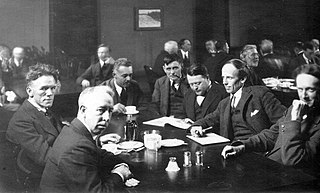Related Research Articles

The Group of Seven, once known as the Algonquin School, was a group of Canadian landscape painters from 1920 to 1933, with "a like vision". It originally consisted of Franklin Carmichael (1890–1945), Lawren Harris (1885–1970), A. Y. Jackson (1882–1974), Frank Johnston (1888–1949), Arthur Lismer (1885–1969), J. E. H. MacDonald (1873–1932), and Frederick Varley (1881–1969). A. J. Casson (1898–1992) was invited to join in 1926, Edwin Holgate (1892–1977) became a member in 1930, and Lionel LeMoine FitzGerald (1890–1956) joined in 1932.
Edward W. (Ted) Godwin, D.F.A. was the youngest member of the Regina Five, a group of five artists all based in Regina, Saskatchewan in 1961 when the group got its name from a show held by the National Gallery of Canada. Godwin is also known for his so-called Tartan paintings of the late 1960s and 1970s.
Takao Tanabe, is a Canadian artist who painted abstractly for decades, but over time, his paintings became nature-based.
Pierre Coupey is a Canadian painter, poet, and editor.
Ron Shuebrook is an American-born Canadian abstract artist living in Guelph, Ontario. He is a prominent teacher and administrator, as well as a writer.
Eleanor Bond is a Canadian multimedia artist and art educator who is best known for reworking the Canadian landscape tradition using a new ecological awareness.
David Sorensen was a Canadian artist.
Arthur Fortescue McKay, best known as Art McKay was a Canadian painter and a member of The Regina Five. Many of his works are modernist abstractions.
Dorothy Elsie Knowles was a Canadian visual artist, most notable for her landscape paintings. She was the widow of William Perehudoff, a fellow artist who is closely associated with the Color Field movement.
David Thauberger, is a Canadian painter known for work that is influenced by popular culture, postcard imagery, folk art, and utopian urban planning concepts.

Wynona Croft Mulcaster was a Canadian painter and teacher from Saskatchewan, best known for her prairie landscapes. She also played an important role in developing competitive riding in Saskatoon.
Ann Kipling L.L.D was a Canadian artist who created impressionistic portraits and landscapes in drawings and prints on paper from direct observation.
Alex Cameron is a visual artist living and working in Toronto, Ontario. He is a member of what has been described as the third generation of artists inspired in their painting style by Jack Bush. During the first part of his career, Cameron fashioned elegantly drawn shapes into abstractions; in the latter part of his career, influenced by Tom Thomson and the Group of Seven, he sought to delineate landscape in his semi-abstract work.
Linda Craddock is a Canadian visual artist living in Calgary, Alberta. Her work has been featured in exhibitions since 1973.
Bernadette Phan is a Vancouver based visual artist working with painting and drawing.
Joice M. Hall is a Canadian artist from Alberta, now based in British Columbia. She is known primarily as a landscape painter.

John Hall is a Canadian modernist painter from Alberta, known for his highly realistic painting style.
Douglas Bentham has been since the late 1960s, acknowledged as one of Canada's pre-eminent producer of large-scale welded steel sculpture.
Ian M. Thom is a Canadian curator, author, and art historian, well known for his exhibitions and major catalogues and books on Canadian Art and international art. In his 30-year duration at the Vancouver Art Gallery, his unceasing dedication to Canadian art and the Vancouver Art Gallery collection, has contributed to better understanding the achievements of Canadian and world art.
John Hartman is a Canadian painter and printmaker based in Ontario.
References
- 1 2 3 4 Wylie, Liz (ed.). "David Alexander: The Shape of Place". www.gallery.ca. McGill-Queen`s University Press. pp. 86–96. Retrieved July 21, 2020.
- 1 2 3 4 5 6 Wylie, Liz (2012). David Alexander: The Landscape is the Evidence in David Alexander: The Shape of Place. Montreal: McGill-Queen`s University Press. p. 7. Retrieved August 10, 2021.
- 1 2 3 4 5 Alexander, David. "Artist Page". www.slnac.ca. Saskatchewan Artist NAC (Network for Art Collecting). Retrieved July 21, 2020.
- 1 2 Maclean, Douglas. "David Alexander and John Hartman, Far and Wide: Alberta Landscapes at The Art Gallery of Alberta". www.gallerieswest.ca. Gallerieswest, December 31, 2006. Retrieved July 21, 2020.
- ↑ "Members since 1880". Royal Canadian Academy of Arts. Archived from the original on May 26, 2011. Retrieved July 21, 2020.
- ↑ Wylie, Liz (ed.). "David Alexander: The Shape of Place". www.gallery.ca. McGill-Queen`s University Press. p. 97. Retrieved July 21, 2020.
- 1 2 Dault, Gary Michael. "Gallery Going - David Alexander". www.probertsongallery.com/. The Globe and Mail, 05/08/2004. Retrieved July 21, 2020.
- 1 2 "Okanagan-based artist, David Alexander, opens show at the Kelowna Art Gallery". www.kelownacapnews.com. Kelowna capital news. Retrieved July 21, 2020.
- ↑ "Artists". bau-xi.com. Bau-Xi Gallery. Retrieved October 20, 2023.
- ↑ "Exhibitions". /www.probertsongallery.com. Peter Robinson Gallery. Retrieved October 21, 2023.
- ↑ "talk". www.youtube.com. Peter Robinson Gallery. Retrieved October 21, 2023.
- ↑ Wylie, Liz (ed.). "David Alexander: The Shape of Place". www.gallery.ca. McGill-Queen`s University Press. p. 106. Retrieved July 21, 2020.